Plan your visit to Thingvellir National Park, one of the top destinations in Iceland. This natural attraction is a UNESCO World Heritage Site and an essential stop for anyone traveling the country.
Located less than an hour from Reykjavik, the park is often paired with Gullfoss Waterfall and the Geysir Geothermal Area on Golden Circle tours. It is frequently included in lists of the best day trips from Reykjavik.
Why You Can Trust Our Content
Guide to Iceland is the most trusted travel platform in Iceland, helping millions of visitors each year. All our content is written and reviewed by local experts who are deeply familiar with Iceland. You can count on us for accurate, up-to-date, and trustworthy travel advice.
Thingvellir National Park has dramatic cliffs, wide valleys, and Iceland’s largest natural lake. These landscapes were shaped by the Mid-Atlantic Rift, where the North American and Eurasian tectonic plates are slowly moving apart.
Over thousands of years, this movement formed cracks such as Almannagja Gorge. It also created the submerged rift of Silfra Fissure, where glacial water filtered through lava rock becomes crystal clear before flowing into the lake.
Adventurous visitors can join snorkeling tours in Silfra. Another popular option is a Golden Circle tour with Kerid Crater and Fridheimar Farm, which adds more variety along the route.
Things To Know Before Visiting Thingvellir
-
Park schedule: Thingvellir National Park is open year-round, 24 hours a day. There is no entrance fee.
-
Visitor Centre at Hakid: This is the main starting point for your visit to Thingvellir National Park. It’s open daily from 9 AM to 6 PM from April to October and 9 AM to 5 PM from November to March. Hours may vary around Christmas and New Year.
-
Parking fees: 1,000 ISK (about 7 USD) for cars with up to 5 seats and 1,200 ISK (about 9 USD) for vehicles with 6 to 9 seats. One payment is valid for all the main parking lots for the entire day.
-
Time needed: Allow around 90 minutes for a short visit, 3 hours for a full visit, or 4 ot 5 hours if you include Silfra snorkeling.
-
Walking paths: Boardwalks run through Almannagja Gorge, a valley between the North American and Eurasian tectonic plates. Other trails can be rocky and uneven, so wear sturdy shoes.
-
Free summer walking tours: From June to August, park rangers offer a daily free Thingvellir walking tour in English. You can join at 10 AM from Thingvallakirkja Church, or at 2 PM from the Visitor Centre at Hakid.
-
Traveling the Golden Circle: Thingvellir National Park is about 45 minutes by car from Reykjavik. It is usually the first stop on Golden Circle tours.
Geology of Thingvellir National Park

The land at Thingvellir shifts as the tectonic plates move about 0.8 inches (2 centimeters) each year, creating cracks and fissures. The largest is Almannagja Gorge, a massive fault that visitors can walk along.
Volcanic activity also shaped the area. Thingvellir sits in a volcanic zone with lava fields formed by past eruptions in Iceland. These black rocks give the landscape a dramatic contrast against the surrounding grass and water.
Glacial rivers and lakes complete the picture. The Oxara River runs through the valley, and nearby Thingvallavatn Lake is Iceland’s largest natural lake. Clear spring water fills the fissures, including Silfra, a world-famous diving site where visibility can reach more than 300 feet (90 meters).
History of Thingvellir National Park
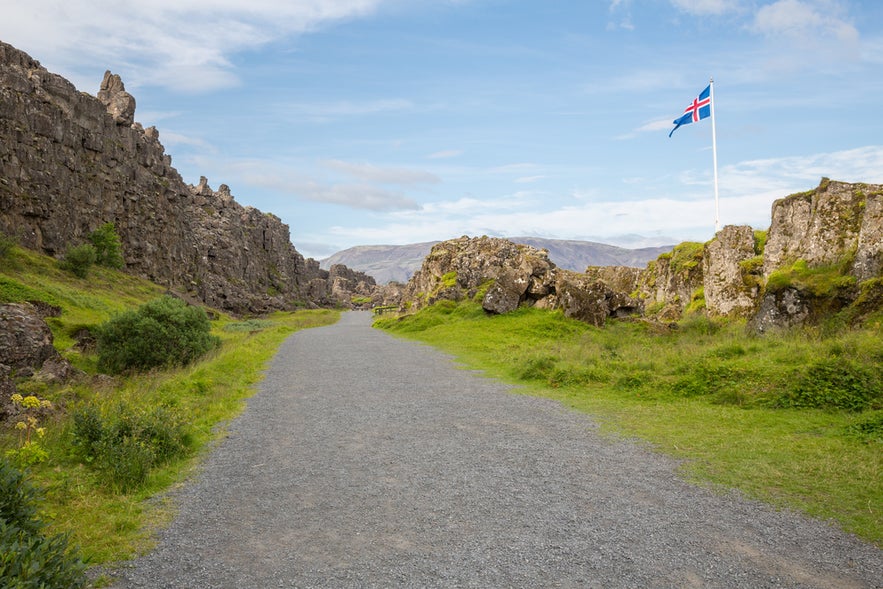 Thingvellir National Park is one of the most important sites in Iceland’s history. It is best known as the birthplace of the Althing, the national parliament founded in 930 A.D., recognized as one of the oldest parliaments in the world.
Thingvellir National Park is one of the most important sites in Iceland’s history. It is best known as the birthplace of the Althing, the national parliament founded in 930 A.D., recognized as one of the oldest parliaments in the world.
For centuries, Viking chieftains and their followers gathered each summer at Law Rock (Logberg). Here, they created new laws, resolved disputes, and forged alliances that shaped the culture and governance of early Iceland.
This tradition continued for more than 800 years, and Thingvellir stands as the center of Iceland’s political and legal history. Another defining moment came in the year 1000 A.D., when the Althing declared that Iceland would adopt Christianity.
Centuries later, on June 17, 1944, the park hosted Iceland’s independence celebrations. Thousands gathered here to mark freedom from Denmark and the founding of the republic.
Best Things To See in Thingvellir
Thingvellir National Park is a key stop on Iceland’s Golden Circle and one of the best places to walk between tectonic plates. Easy paths connect the main sights, so it’s simple to explore.
Start your visit at the Hakid Viewpoint and Visitor Centre, then follow the trails into Almannagja Gorge. Stop at Law Rock to learn about Iceland’s parliament, and continue to the viewing platforms at Oxararfoss Waterfall.
Other highlights include Thingvellir Church, the shoreline of Thingvallavatn Lake, and guided tours at the Silfra Fissure, where you can snorkel or dive between two continents.
Hakid Viewpoint and Visitor Centre in Thingvellir
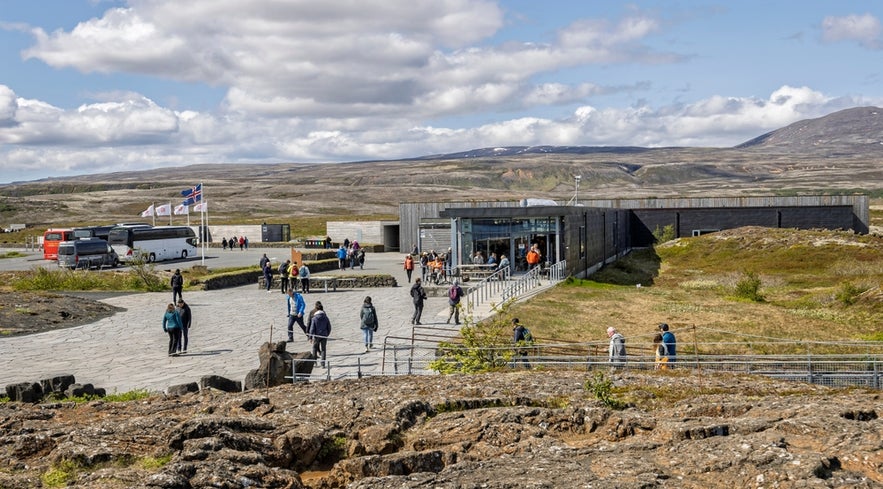 Hakid is the main viewpoint in Thingvellir, with wide views of Almannagja Gorge and Thingvallavatn Lake. It is the best place to start your visit and understand the layout of the park.
Hakid is the main viewpoint in Thingvellir, with wide views of Almannagja Gorge and Thingvallavatn Lake. It is the best place to start your visit and understand the layout of the park.
The Visitor Centre next to Hakid has exhibits on the tectonic plates and the history of the Althing parliament. Maps and models explain what you will see on the trails, including Law Rock and Oxararfoss Waterfall.
From June to August, there’s a free Thingvellir National Park tour, led by a park ranger. These daily tours highlight the park’s history, geology, and landscapes. The tour begins at 2 PM from the Visitor Centre at Hakid, and no advance booking is required.
Before exploring, you can use the restrooms, buy snacks, or ask for advice at the desk. Parking is next to Hakid, and one payment covers all signed lots in the park. From here, follow the boardwalk into the gorge and continue toward the main sights.
Almannagja Gorge in Thingvellir National Park
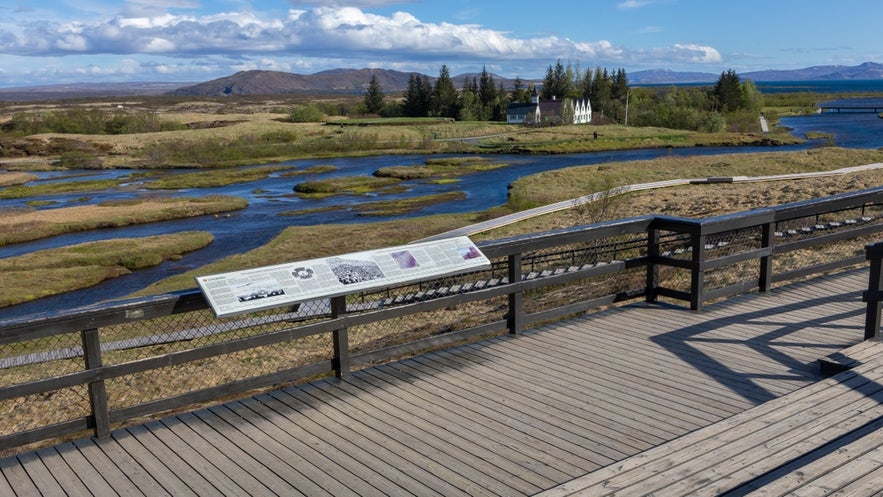 Almannagja Gorge is one of the top sights in Thingvellir National Park, showing where the North American and Eurasian tectonic plates are moving apart. Visitors can walk through the gorge on safe boardwalks.
Almannagja Gorge is one of the top sights in Thingvellir National Park, showing where the North American and Eurasian tectonic plates are moving apart. Visitors can walk through the gorge on safe boardwalks.
The trail begins at the Hakid Viewpoint near the Visitor Centre, with signs along the way explaining the geology in simple terms. You’ll also pass Law Rock, the historic meeting place of Iceland’s parliament.
Conditions change by season. Winter can be icy, spring often wet, summer brings long daylight and more crowds, and autumn colors highlight the cliffs. Early mornings are usually quieter.
Plan 30 to 60 minutes for the gorge, or a little longer if you continue to Oxararfoss Waterfall.
Law Rock (Logberg) in Thingvellir National Park
 Law Rock is the outdoor meeting place of the Althing, Iceland’s early parliament. Leaders gathered here from around the year 930 A.D. to announce laws, settle disputes, and share news. It remains one of the most historic sites in Thingvellir.
Law Rock is the outdoor meeting place of the Althing, Iceland’s early parliament. Leaders gathered here from around the year 930 A.D. to announce laws, settle disputes, and share news. It remains one of the most historic sites in Thingvellir.
The rock is easy to reach on foot. Start at the Hakid Viewpoint near the Visitor Centre and follow the main boardwalk through Almannagja Gorge. Law Rock sits beside the path with clear signs that explain its history.
For photos, face the valley with Law Rock in the foreground to capture both the historic site and the rift behind it. On clear nights, this open area is also a good spot for northern lights photography.
Most visitors stop here for 10 to 20 minutes before continuing toward Oxararfoss Waterfall or returning to the parking areas. Early morning or late afternoon usually offer quieter times with fewer tour groups.
Oxararfoss Waterfall in Thingvellir National Park
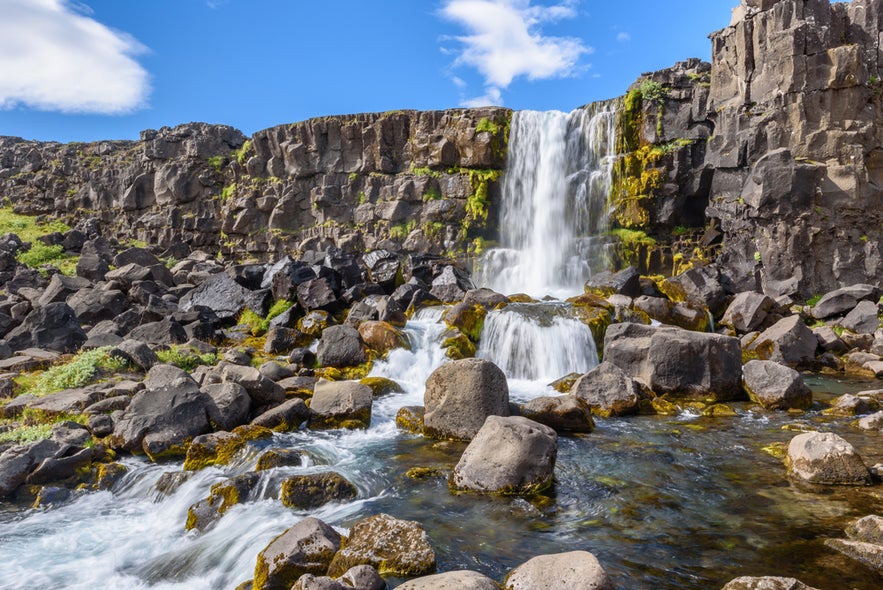 Oxararfoss is the only major waterfall inside Thingvellir National Park. The short, easy path makes it a good stop for first-time visitors and families.
Oxararfoss is the only major waterfall inside Thingvellir National Park. The short, easy path makes it a good stop for first-time visitors and families.
Viewing platforms give close views of the cascade against black basalt cliffs. The lower platform shows the full drop, while the side path offers an angled shot with the river in the frame.
The waterfall is strongest after rain or snowmelt, and in winter it can freeze into tall ice columns. Trails are mostly boardwalk and gravel with a few short slopes. Wear sturdy shoes, especially in wet or icy conditions.
The closest access is from parking area P2, but you can also come from P3 or walk in from the Almannagja Boardwalk if starting at Hakid. Most visitors spend 20 to 40 minutes here, depending on parking and photo stops.
Silfra Fissure in Thingvellir National Park
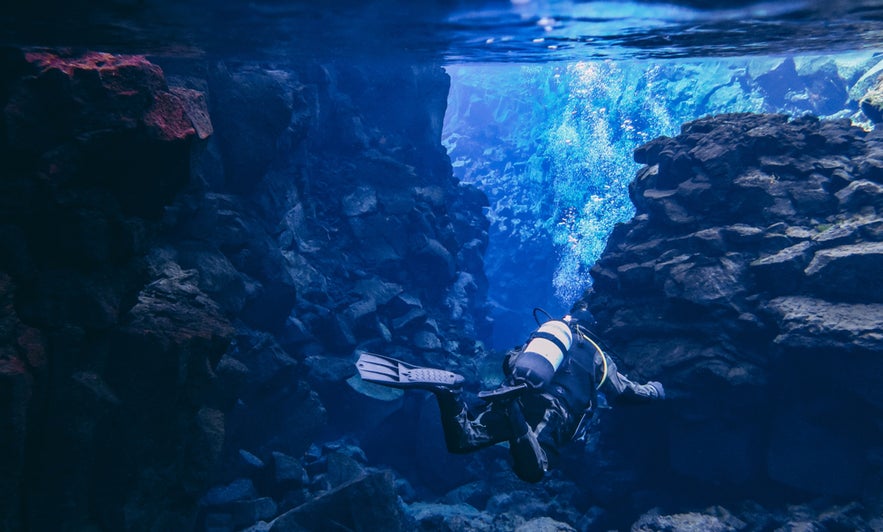 Silfra Fissure is a spring-fed rift in Thingvellir National Park with some of the clearest water in the world. It lies between the North American and Eurasian tectonic plates, and a guided Silfra snorkeling tour lets you swim through this calm channel.
Silfra Fissure is a spring-fed rift in Thingvellir National Park with some of the clearest water in the world. It lies between the North American and Eurasian tectonic plates, and a guided Silfra snorkeling tour lets you swim through this calm channel.
Most tours begin at the Silfra area near parking P5, close to Thingvellir Church. Some operators also include pickup in Reykjavik as part of a Golden Circle and snorkeling day trip.
Water temperatures stay between 36 F and 39 F (2 C and 4 C) year-round. Operators provide a drysuit, neoprene hood, and gloves, and you should wear warm base layers underneath. Your hands and face will still feel cold, but the swim is slow and gentle.
Snorkeling in Silfra is not suitable for everyone. Tour operators set age, height, and weight limits, and those sensitive to cold or with certain medical conditions may not be able to join. Spaces are limited, so it is best to book in advance, especially for the summer.
Thingvallavatn Lake in Thingvellir National Park
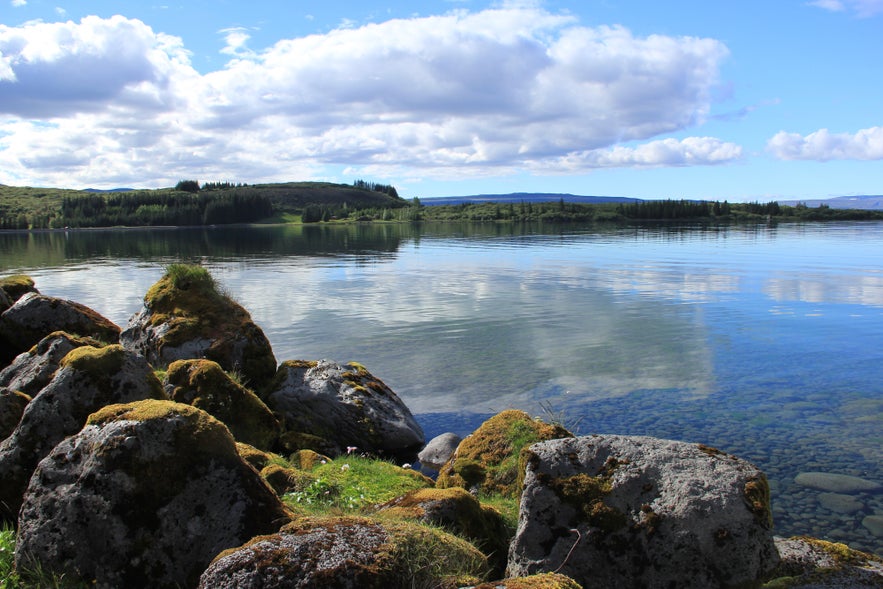 Thingvallavatn, also called Thingvellir Lake, is the largest natural lake in Iceland. On calm days, the water is very clear, and the wide views show the scale of the surrounding national park.
Thingvallavatn, also called Thingvellir Lake, is the largest natural lake in Iceland. On calm days, the water is very clear, and the wide views show the scale of the surrounding national park.
The easiest access is from parking area P5 near Thingvellir Church and the Silfra area. Short, signed paths lead to the shore, most of them flat or gently sloped. Plan 15 to 30 minutes for a relaxed stop, or longer if you want to take photos or sit by the water.
Morning is usually the calmest time, giving clear reflections on the surface of the lake for photography. Later in the day, wind can roughen the water, and in winter, ice may form along the edges.
In summer, you may see birdlife along the shore. The lake is also home to several forms of Arctic char. Many travelers pair a visit to Thingvallavatn with a stop at the nearby church before continuing the Golden Circle Route toward Geysir Geothermal Area and Gullfoss Waterfall.
Thingvellir Church and Cemetery
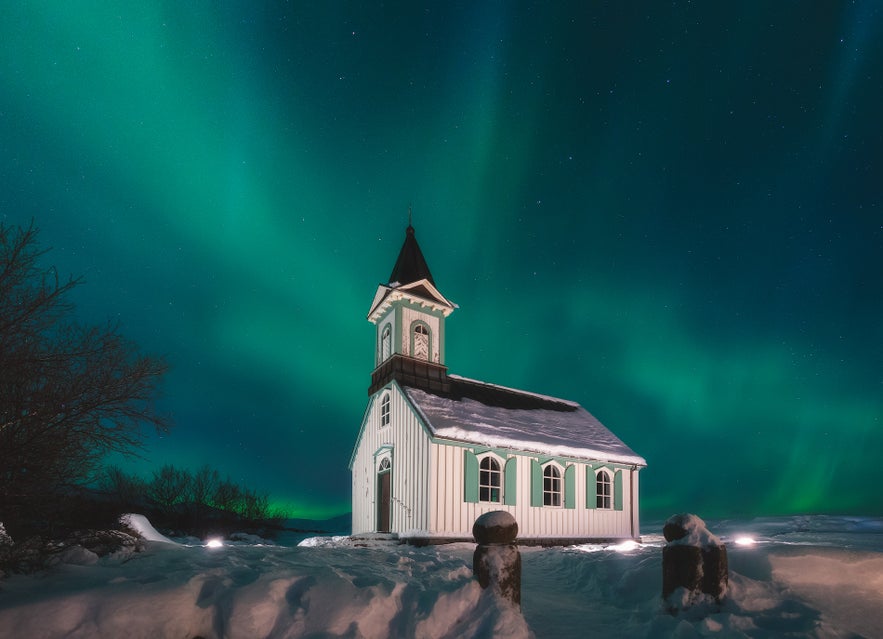 Thingvellir Church stands near the shore of Thingvallavatn Lake, beside a small cluster of historic buildings. The church is simple and peaceful, with a cemetery next to it that reflects Iceland’s Christian heritage and everyday life.
Thingvellir Church stands near the shore of Thingvallavatn Lake, beside a small cluster of historic buildings. The church is simple and peaceful, with a cemetery next to it that reflects Iceland’s Christian heritage and everyday life.
The church is easy to reach on foot from parking area P5, which also serves the Silfra area. The site is mainly viewed from the outside, and a short, signed path leads to the site. Most visitors spend 10 to 20 minutes here to look around, take photos, and enjoy the views.
If you are exploring Thingvellir as a loop, the church pairs well with a lakeside stop at Thingvallavatn. Many travelers visit after walking through Almannagja Gorge and Law Rock, then continue the Golden Circle Route toward Geysir and Gullfoss, or return to Reykjavik.
From June to August, this area is also the meeting point for the free Thingvellir guided tour, led by a park ranger. The tour begins at 10 AM from Thingvellir Church, and no advance booking is required.
How To Get to Thingvellir National Park
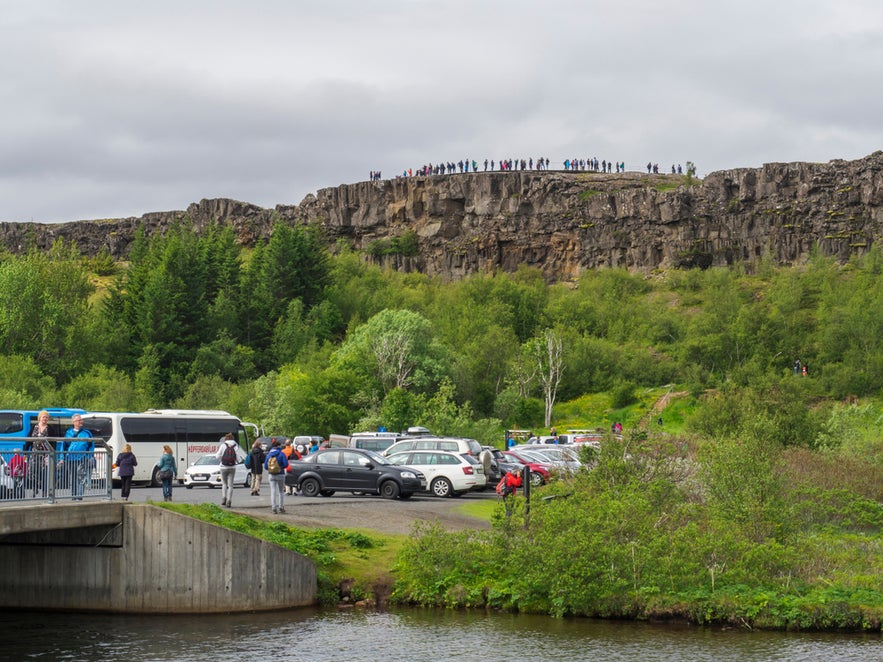 Thingvellir National Park is part of Iceland’s Golden Circle and lies about 28 miles (45 kilometers) from Reykjavik. You can get to Thingvellir by car or by joining a guided tour, but there is no direct public bus service to the park.
Thingvellir National Park is part of Iceland’s Golden Circle and lies about 28 miles (45 kilometers) from Reykjavik. You can get to Thingvellir by car or by joining a guided tour, but there is no direct public bus service to the park.
Driving to Thingvellir National Park From Reykjavik
 The drive from Reykjavik to Thingvellir takes about 45 minutes. Leave the city toward the town of Mosfellsbaer on Route 1 (Ring Road), then follow Route 36 (Thingvallavegur) directly to the park.
The drive from Reykjavik to Thingvellir takes about 45 minutes. Leave the city toward the town of Mosfellsbaer on Route 1 (Ring Road), then follow Route 36 (Thingvallavegur) directly to the park.
Roads are paved and well signed, but in winter they can be icy and windy, so always check the weather and Iceland’s road status before you go.
Golden Circle Tours to Thingvellir National Park
Many Golden Circle tours include a stop at Thingvellir and offer hotel or central pickup in Reykjavik. This is the easiest option if you do not want to drive.
Here are some available choices:
-
Golden Circle Afternoon Tour: A short, guided option that covers Thingvellir, Gullfoss, and Geysir in just half a day.
-
Golden Circle Tour & Langjokull Snowmobiling: Visit Thingvellir and add a snowmobile ride on Iceland’s second-largest glacier.
-
Golden Circle Super Jeep & Snowmobiling Tour: A premium small-group tour with off-road driving and glacier adventure.
-
Golden Circle & Northern Lights Tour: Explore Thingvellir, Geysir, and Gullfoss by day, then hunt for the aurora at night.
-
Golden Circle Tour & Horseback Riding: Combine Icelandic horse riding with sightseeing at Thingvellir and nearby highlights.
-
Golden Circle Hop-On Hop-Off Bus Tour: A flexible option where you can explore at your own pace.
Some Silfra snorkeling tours also provide pickup, while others meet at the Silfra area near parking P5. Always confirm the meeting point and pickup time when booking.
Here are the best options:
-
Snorkel in Silfra Tour: Swim between tectonic plates in one of the world’s clearest waters.
-
Private Silfra Snorkeling Day Tour With Photos: A private guided snorkeling experience with flexible timing and photos.
-
Silfra Snorkeling & Laugarvatn Fontana Spa Visit: Combine a cold-water snorkel with a relaxing geothermal spa visit.
-
Silfra Snorkeling & Horseback Riding: A day of adventure with horseback riding and underwater photos included.
-
Silfra Night Freedive Tour: A unique freediving experience in Silfra after dark.
-
Private Super Jeep Golden Circle & Silfra Snorkeling: Explore the Golden Circle in a private super jeep and snorkel Silfra with a guide.
Where To Park at Thingvellir National Park
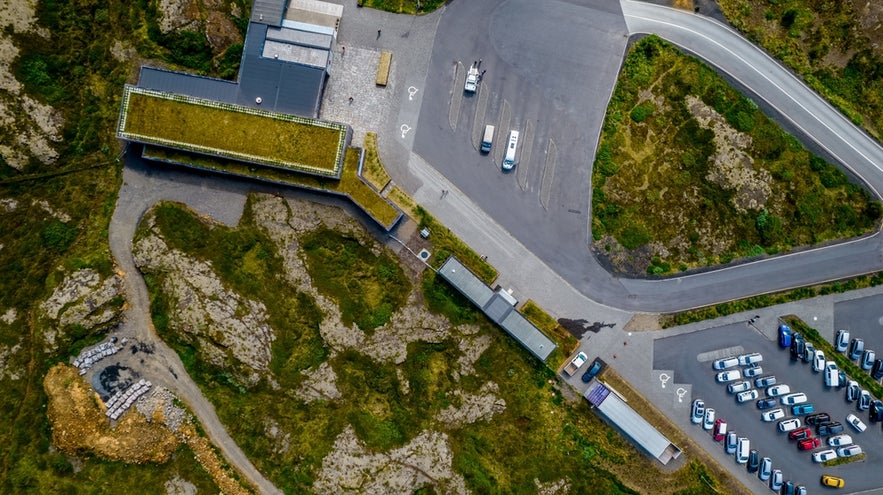 Parking at Thingvellir is spread across four main lots: P1 Hakid, P2 Oxararfoss, P3 Oxararfoss, and P5 Church and Silfra. One day's payment covers them all, so you can move between lots without paying again.
Parking at Thingvellir is spread across four main lots: P1 Hakid, P2 Oxararfoss, P3 Oxararfoss, and P5 Church and Silfra. One day's payment covers them all, so you can move between lots without paying again.
The fee is 1,000 ISK (about 7 USD) for cars with up to five seats and 1,200 ISK (about 9 USD) for vehicles with six to nine seats. You pay at a machine by entering your license plate number, and the system automatically recognizes your car in each lot. No ticket is needed.
Lots are busiest in summer and on weekends, so arriving early or later in the day helps. In winter, watch for icy conditions when moving around the lots and paths.
-
P1 Hakid (Visitor Centre Parking): P1 Hakid is the most popular parking area in Thingvellir National Park, located next to the Hakid Viewpoint and Visitor Centre. It gives direct access to views over Almannagja Gorge and Thingvallavatn Lake. From here, you can follow the boardwalk into Almannagja and continue to Law Rock.
-
P2 Oxararfoss (Lower Lot): P2 Oxararfoss is the closest parking lot to the viewing platforms at Oxararfoss Waterfall. The short, easy path makes it ideal for families or visitors with limited time. You can also walk to the falls from P1, but P2 saves time and keeps the route simple.
-
P3 Oxararfoss (Upper or North Access): P3 Oxararfoss is a quieter option that also leads to the waterfall and nearby trails. It is often less crowded than P2, especially on busy summer afternoons, and works well if other lots are full or if you prefer a more peaceful route.
-
P5 Church and Silfra Parking: P5 serves Thingvellir Church, the shores of Thingvallavatn Lake, and the meeting point for most Silfra snorkeling tours. Many travelers move their car here after exploring Almannagja and Oxararfoss, since the same parking fee covers the entire day across all lots.
How Much Time To Spend at Thingvellir
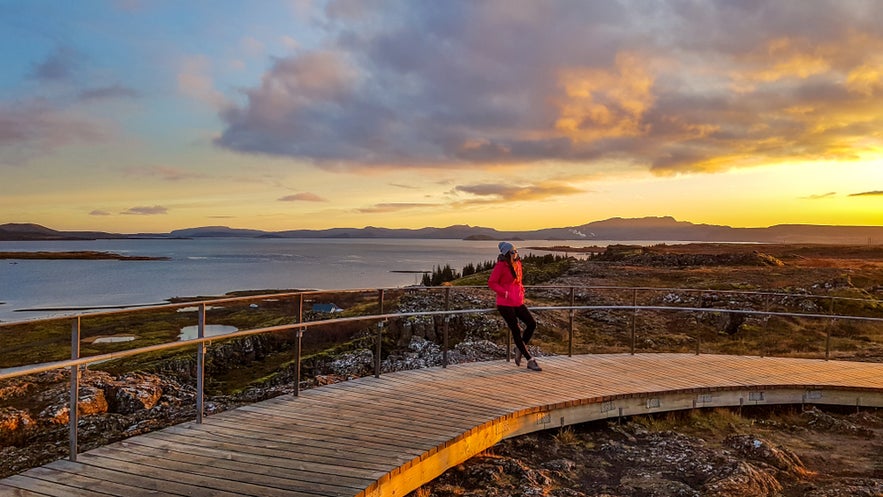 Most visitors spend between 1.5 and 3 hours inside Thingvellir National Park, or 4 to 5 hours if joining a Silfra snorkeling tour. If you include the 45-minute drive each way from Reykjavik, plan on a total of 3 to 6 hours, depending on your pace and activities.
Most visitors spend between 1.5 and 3 hours inside Thingvellir National Park, or 4 to 5 hours if joining a Silfra snorkeling tour. If you include the 45-minute drive each way from Reykjavik, plan on a total of 3 to 6 hours, depending on your pace and activities.
-
90-Minute on Site: Allow about 90 minutes for a short walking route. Start at the Hakid Viewpoint, then follow the boardwalk into Almannagja Gorge. Stop at Law Rock, continue to Oxararfoss Waterfall, and return to your car.
-
3 Hours on Site: Plan for about 3 hours to see Thingvellir at a comfortable pace. Begin at the Visitor Centre, then walk through Almannagja Gorge to Law Rock and Oxararfoss. Afterward, drive to P5 Church and Silfra Parking to visit Thingvellir Church and stroll along the lake.
-
4 to 5 Hours on Site: Set aside 4 to 5 hours if you want to take a snorkeling tour in Silfra. Start at Hakid and Almannagja before heading to P5, where most tours meet. The snorkeling activity takes 2 to 3 hours, including a briefing. After the swim, you can stop at Thingvellir Church or enjoy the lakeshore before continuing on the Golden Circle.
Other Golden Circle Highlights Near Thingvellir National Park
The Golden Circle is Iceland’s most famous sightseeing route, covering about 190 miles (300 kilometers) in a round trip from Reykjavik. It begins with Thingvellir National Park, then continues to the Haukadalur Geothermal Area and to Gullfoss Waterfall.
Other attractions near Thingvellir include Laugarvatn Fontana Spa, Bruarfoss Waterfall, Fridheimar Tomato Farm, Kerid Crater, and Faxafoss Waterfall. All of these stops are within about an hour’s drive of the park, so they fit easily into a Golden Circle itinerary.
Laugarvatn Fontana Spa
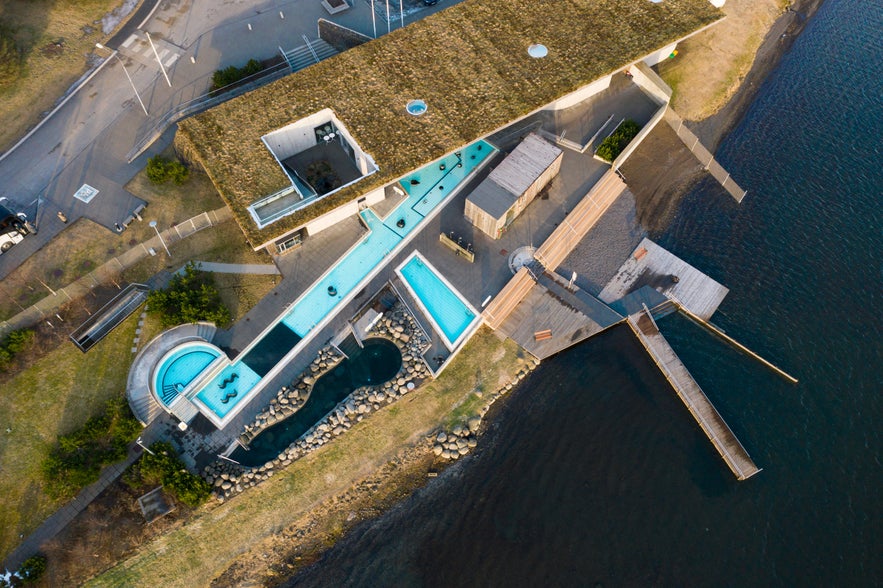 Located about 15 miles (25 kilometers), or a 25-minute drive from Thingvellir, Laugarvatn Fontana Spa sits on the shore of Lake Laugarvatn. The complex includes outdoor hot pools, steam rooms heated by natural vents, and direct access to the lake for cold plunges.
Located about 15 miles (25 kilometers), or a 25-minute drive from Thingvellir, Laugarvatn Fontana Spa sits on the shore of Lake Laugarvatn. The complex includes outdoor hot pools, steam rooms heated by natural vents, and direct access to the lake for cold plunges.
The entrance to the Fontana Spa covers admission to the pools, steam rooms, and lake bathing area. Visitors can also experience geothermal rye bread baking and tasting at Fontana Spa, where fresh rye bread is cooked in the hot ground and served warm with butter.
Smaller and quieter than the Blue Lagoon, Laugarvatn Fontana is a good choice for travelers who want a relaxing spa stop on the Golden Circle.
Bruarfoss Waterfall
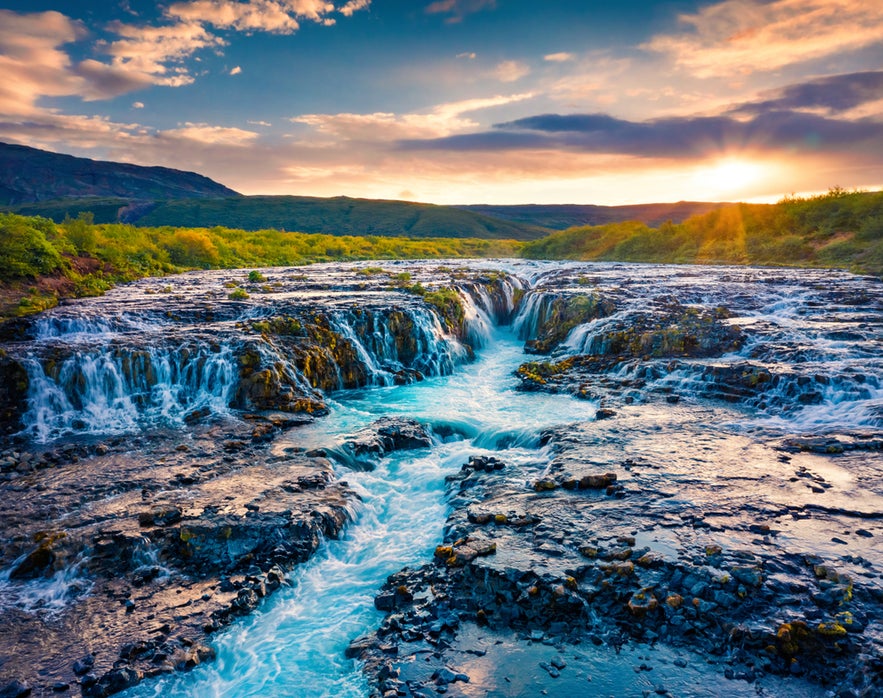 From Thingvellir, Bruarfoss Waterfall is 20 miles (32 kilometers) away, which is about 30 minutes by car to the trailhead. A 45 to 60-minute round-trip hike along the Bruara River leads to a vivid blue waterfall framed by dark volcanic rock. Less visited than Gullfoss, it is one of the most photogenic waterfalls near Thingvellir.
From Thingvellir, Bruarfoss Waterfall is 20 miles (32 kilometers) away, which is about 30 minutes by car to the trailhead. A 45 to 60-minute round-trip hike along the Bruara River leads to a vivid blue waterfall framed by dark volcanic rock. Less visited than Gullfoss, it is one of the most photogenic waterfalls near Thingvellir.
Travelers who prefer guided experiences can book a private Golden Circle tour with Bruarfoss Waterfall, which includes transport and local insight, along with the chance to hike to the falls. Good footwear is recommended, as the trail can be muddy in wet weather.
Fridheimar Tomato Farm
 About 30 miles (48 kilometers), or 40 minutes from Thingvellir, Fridheimar Tomato Farm sits near the village of Reykholt. This family-run greenhouse and restaurant is famous for tomato dishes grown year-round with geothermal heat.
About 30 miles (48 kilometers), or 40 minutes from Thingvellir, Fridheimar Tomato Farm sits near the village of Reykholt. This family-run greenhouse and restaurant is famous for tomato dishes grown year-round with geothermal heat.
Guests can enjoy tomato soup served with fresh bread, tomato beer, and even tomato ice cream. The farm shop also offers sauces and jams that you can purchase to take home.
Many guided options include a stop here, such as a Golden Circle tour from Reykjavik with Fridheimar Greenhouse, which combines sightseeing with a unique dining experience. The farm is one of the most popular lunch stops along the Golden Circle Route.
Haukadalur Geothermal Area (Strokkur and Geysir)
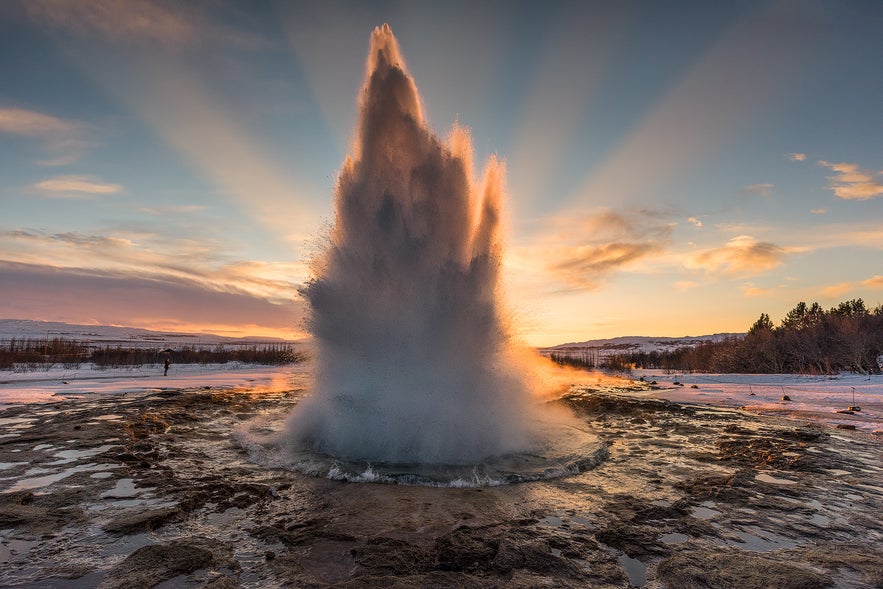 The Haukadalur Geothermal Area lies 37 miles (60 kilometers), about a 45-minute drive from Thingvellir. It’s best known for the geysers Strokkur and Geysir.
The Haukadalur Geothermal Area lies 37 miles (60 kilometers), about a 45-minute drive from Thingvellir. It’s best known for the geysers Strokkur and Geysir.
Strokkur erupts every 5–10 minutes, shooting boiling water up to 100 feet (30 meters), while Geysir is mostly dormant. The valley also has steaming vents, bubbling mud pools, and colorful mineral deposits.
Some operators offer a Langjokull snowmobile tour from the Geysir Area, combining geothermal sights with a ride across Iceland’s second-largest glacier.
Gullfoss Waterfall
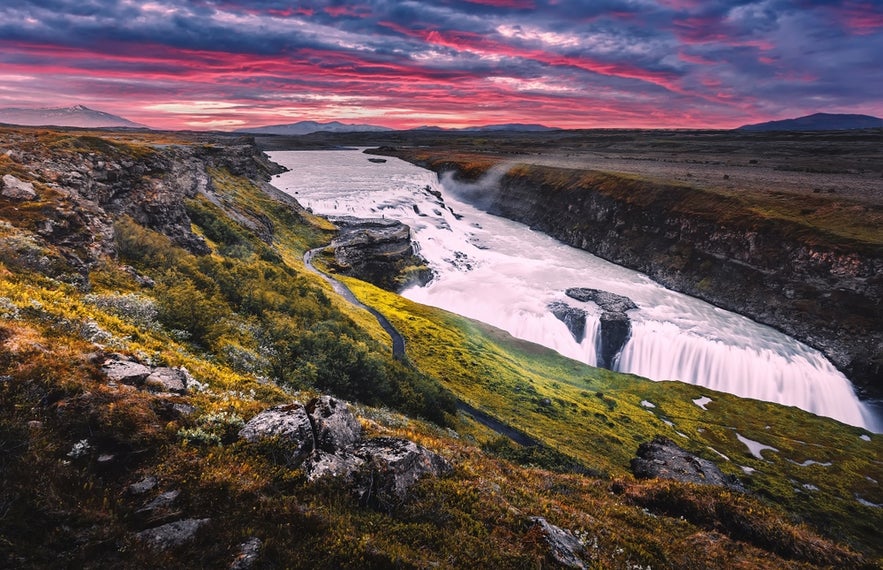 About an hour’s drive from Thingvellir, covering roughly 49 miles (79 kilometers), is Gullfoss, or the “Golden Falls.” This two-tiered waterfall plunges into a deep canyon carved by the Hvita River.
About an hour’s drive from Thingvellir, covering roughly 49 miles (79 kilometers), is Gullfoss, or the “Golden Falls.” This two-tiered waterfall plunges into a deep canyon carved by the Hvita River.
Viewing paths let you see Gullfoss from both high and close perspectives. On sunny days, rainbows often appear in the spray, and Gullfoss is often described as one of the most photogenic stops on the Golden Circle.
From Gullfoss, you can also join adventure tours. A popular option is the ice caving and snowmobiling tour on Langjokull Glacier from Gullfoss Waterfall, which combines sightseeing with glacier exploration.
Kerid Crater
 Kerid Crater lies 34 miles (55 kilometers) from Thingvellir, about a 45-minute drive away. This 3,000-year-old volcanic caldera is known for its steep red slopes and the vivid blue-green lake at the bottom.
Kerid Crater lies 34 miles (55 kilometers) from Thingvellir, about a 45-minute drive away. This 3,000-year-old volcanic caldera is known for its steep red slopes and the vivid blue-green lake at the bottom.
Entry to Kerid costs about 605 ISK (5 USD), which supports maintenance of the paths and facilities. Visitors can walk the rim for wide views or follow the short path down to the shore.
Travelers who prefer not to drive can join a Golden Circle and Kerid Crater bus tour from Reykjavik, which includes admission and sightseeing stops along the route.
Faxafoss Waterfall
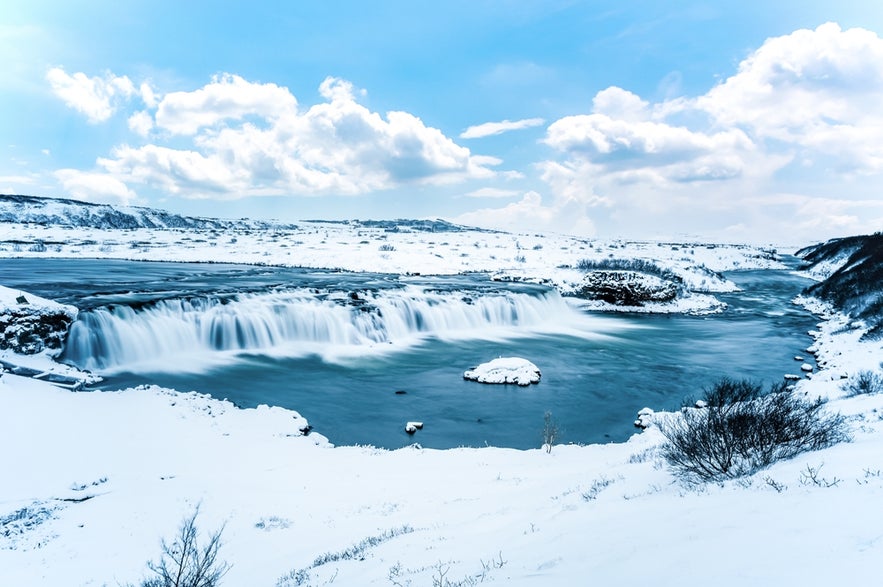 Faxafoss is 23 miles (37 kilometers) from Thingvellir, about a 35-minute drive away. This wide, gentle waterfall on the Tungufljot River is quieter than Gullfoss and offers a peaceful stop on the Golden Circle Route.
Faxafoss is 23 miles (37 kilometers) from Thingvellir, about a 35-minute drive away. This wide, gentle waterfall on the Tungufljot River is quieter than Gullfoss and offers a peaceful stop on the Golden Circle Route.
Rental cars are the easiest way to visit Faxafoss, as it is often skipped in guided tours. Most travelers spend about 15 to 20 minutes enjoying the broad cascade and calm riverside surroundings before continuing their journey.
Where To Stay Near Thingvellir
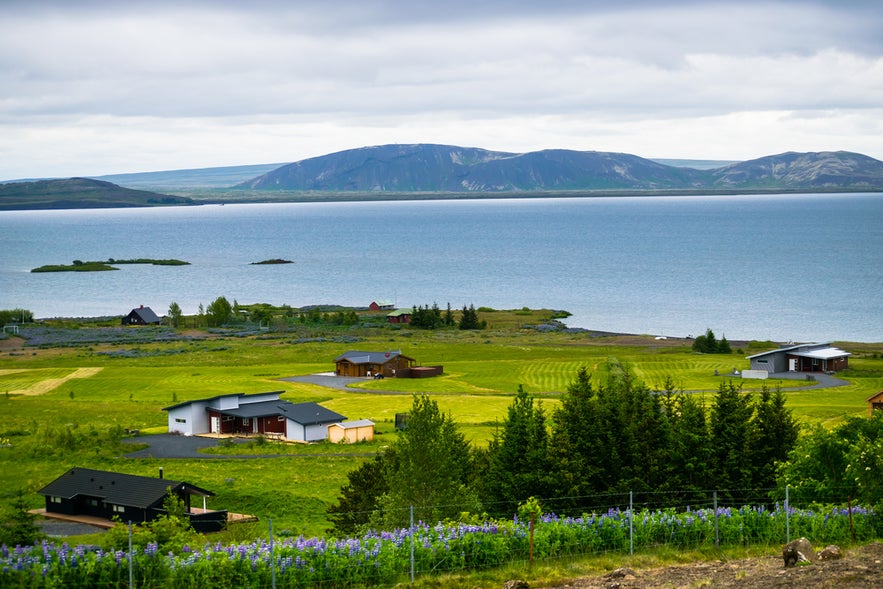 There are no hotels inside Thingvellir National Park, as it is a protected UNESCO World Heritage Site. The closest option is the ION Adventure Hotel, which sits on the park’s edge with views of the water.
There are no hotels inside Thingvellir National Park, as it is a protected UNESCO World Heritage Site. The closest option is the ION Adventure Hotel, which sits on the park’s edge with views of the water.
You’ll also find cottages close to the park, nearby hotels along the Golden Circle, guesthouses in Laugarvatn, and the official Leirar Campsite.
ION Adventure Hotel
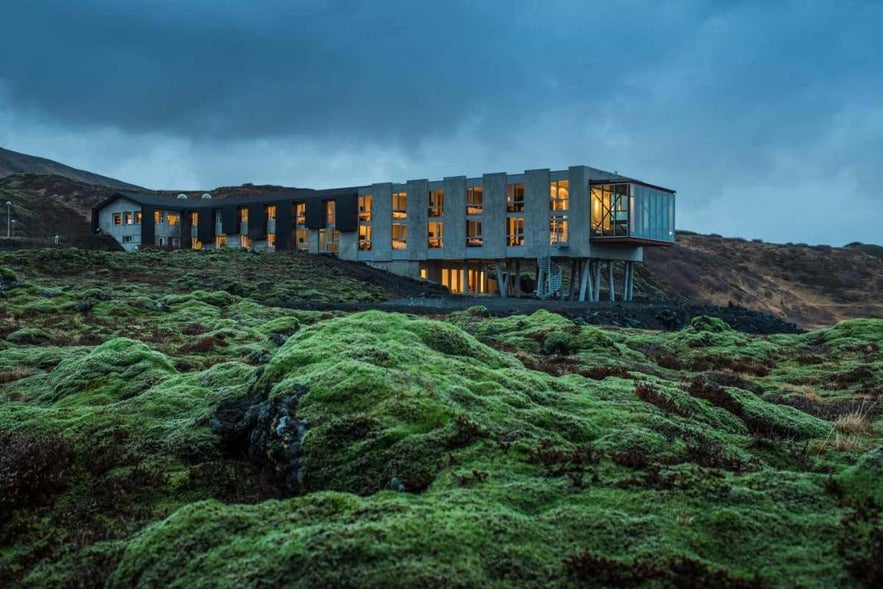 The ION Adventure Hotel is about a 1-hour drive from Reykjavik and sits just up against Thingvellir National Park. The hotel’s design is modern and minimalist, with large windows overlooking Thingvallavatn Lake, the lava fields, and the mountains.
The ION Adventure Hotel is about a 1-hour drive from Reykjavik and sits just up against Thingvellir National Park. The hotel’s design is modern and minimalist, with large windows overlooking Thingvallavatn Lake, the lava fields, and the mountains.
Amenities include a geothermal pool, spa, and the Silfra Restaurant, which serves locally sourced Icelandic cuisine.
Hotel Geysir
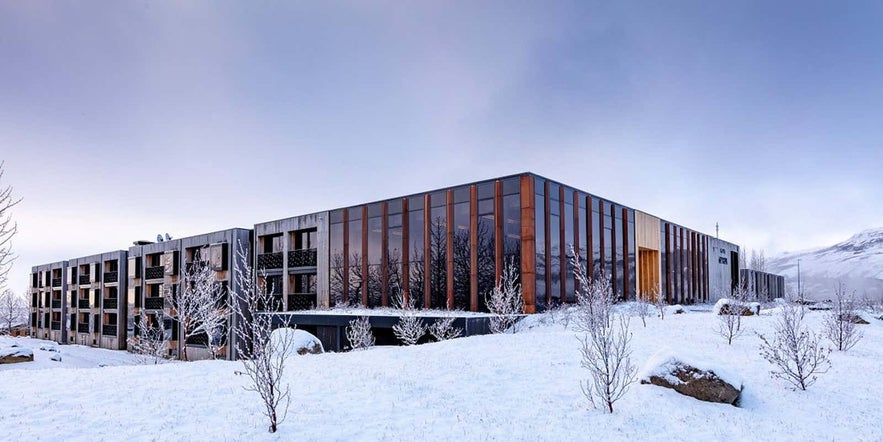 Hotel Geysir is less than an hour’s drive from Thingvellir, located directly across from the Geysir Geothermal Area. Guests stay within walking distance of Strokkur and enjoy easy access to Gullfoss Waterfall.
Hotel Geysir is less than an hour’s drive from Thingvellir, located directly across from the Geysir Geothermal Area. Guests stay within walking distance of Strokkur and enjoy easy access to Gullfoss Waterfall.
The hotel offers modern rooms and stunning views of the hot spring valley. It also has five on-site restaurants, including fine dining at Geysir Restaurant and unique outdoor dining such as Soup in the Forest.
Heradsskolinn Historic Guesthouse
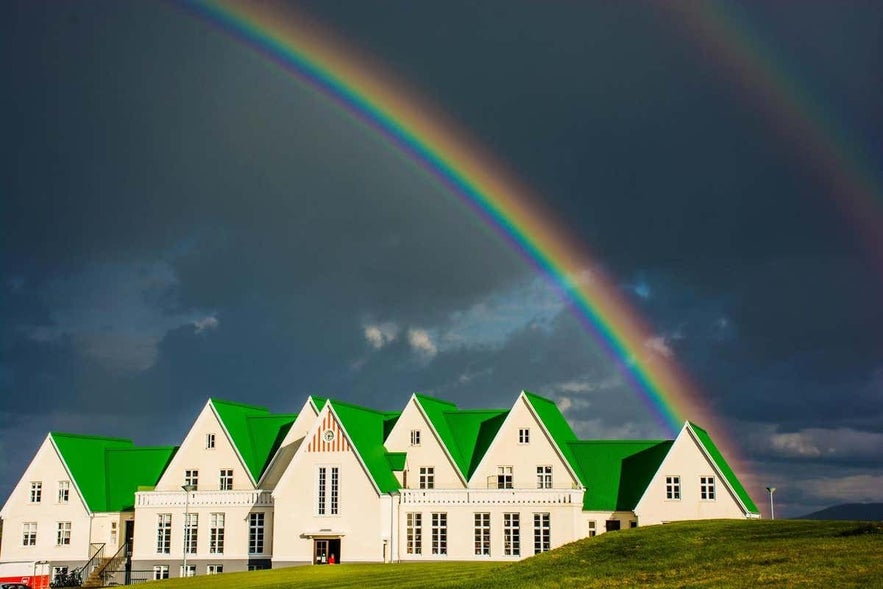 In the village of Laugarvatn, 25 minutes from Thingvellir National Park, the Heradsskolinn Historic Guesthouse offers a cozy, affordable stay along the Golden Circle. Originally built in 1928 as a school, it has been restored into a charming guesthouse.
In the village of Laugarvatn, 25 minutes from Thingvellir National Park, the Heradsskolinn Historic Guesthouse offers a cozy, affordable stay along the Golden Circle. Originally built in 1928 as a school, it has been restored into a charming guesthouse.
Guests can choose private rooms or budget dorms, with a mix of shared and private bathrooms. There is also an on-site cafe serving homemade meals. The location is convenient for visiting Laugarvatn Fontana Spa.
Lundur Cottage With Hot Tub Near Thingvellir
 Located just over 3 miles (5 kilometers) from Thingvellir National Park, Lundur Cottage is a modern retreat that sleeps up to six people. It has three bedrooms, a spacious living area, a fully equipped kitchen, and heated floors in the master bedroom.
Located just over 3 miles (5 kilometers) from Thingvellir National Park, Lundur Cottage is a modern retreat that sleeps up to six people. It has three bedrooms, a spacious living area, a fully equipped kitchen, and heated floors in the master bedroom.
Outside, you’ll find a veranda with a hot tub, a sauna, and a BBQ grill. The cottage also includes family-friendly features such as a playground, toys, a high chair, and a crib.
Leirar Campsite at Thingvellir National Park
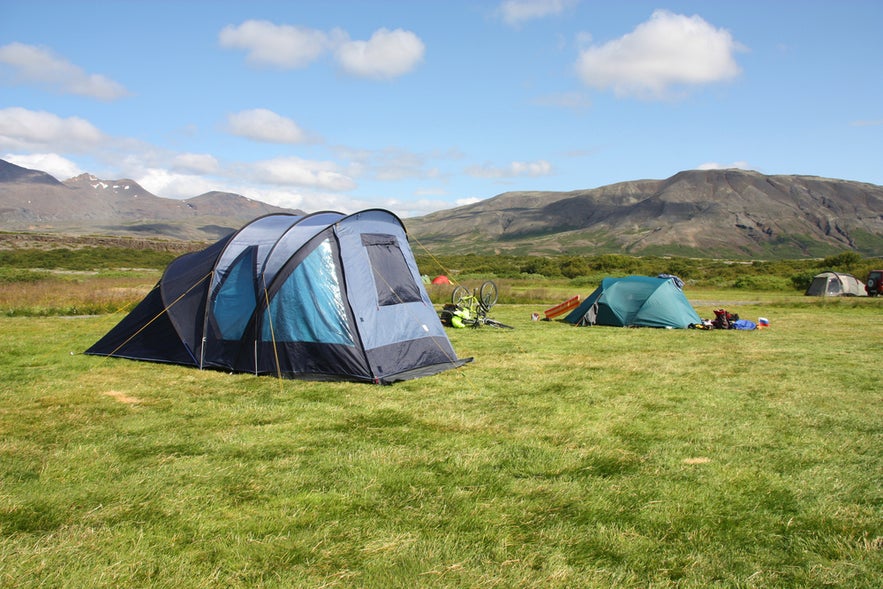 Camping in Iceland is a popular way to experience the outdoors, and Thingvellir National Park has one designated site. The Leirar Campsite is open from June to September and provides facilities such as restrooms, showers, and electricity for campervans.
Camping in Iceland is a popular way to experience the outdoors, and Thingvellir National Park has one designated site. The Leirar Campsite is open from June to September and provides facilities such as restrooms, showers, and electricity for campervans.
The nightly fee is about 1,600–2,000 ISK (11–14 USD) per person, with children under 13 usually staying free. Electricity has an extra cost if required.
Booking is not always necessary, but it is recommended in July and August when the Golden Circle is busiest. Leirar is also a common stop on camping tours and serves as a convenient base for exploring the park.
FAQs About the Thingvellir National Park

What is special about Thingvellir National Park?
Thingvellir National Park is unique because it combines history and geology in one site. It was the meeting place of the Althing, the world’s oldest parliament, founded in 930 A.D.
Geologically, it sits on the rift between the North American and Eurasian tectonic plates, one of the few places on land where you can see this boundary. It is also home to Silfra Fissure, one of the clearest snorkeling and diving sites in the world.
When is the best time to visit Thingvellir National Park?
The best time to visit Thingvellir National Park is from May to September. The weather is milder, the days are long, and the paths are easier to walk on. This period is ideal for sightseeing, hiking, and photography.
Winter is also a good option if you want fewer crowds, snowy landscapes, or a chance to see the northern lights, but paths can be icy and daylight is limited.
Was Game of Thrones filmed in Thingvellir?
Yes. Game of Thrones filmed scenes in Thingvellir National Park, especially in Season Four. Almannagja Gorge and other dramatic landscapes in the park appear as part of the setting north of the Wall. Iceland, in general, has been the primary filming location since Season Two.
How cold is the water in Silfra Fissure?
The water in Silfra Fissure stays between 36 F and 39 F (2 C and 4 C) all year. Snorkeling and diving tours usually provide a drysuit, neoprene hood, and gloves to protect against the cold.
Where are the tectonic plates in Thingvellir National Park?
The rift between the North American Plate and the Eurasian Plate runs through Thingvellir. The separation is easiest to see in Almannagja Gorge and in the clear waters of Silfra Fissure.
Can you walk between tectonic plates in Thingvellir?
Yes. The boardwalk through Almannagja Gorge lets visitors walk between the cliffs of the North American and Eurasian plates. Thingvellir is one of the only places in the world where you can experience this on land.
Do I need to book parking or tours ahead when visiting Thingvellir National Park?
Parking does not need to be booked in advance, since payment machines are available on site. However, a tour for Silfra snorkeling and a Golden Circle day trip should be booked early, especially in summer, because slots are limited.
Make the Most of Your Trip To Thingvellir
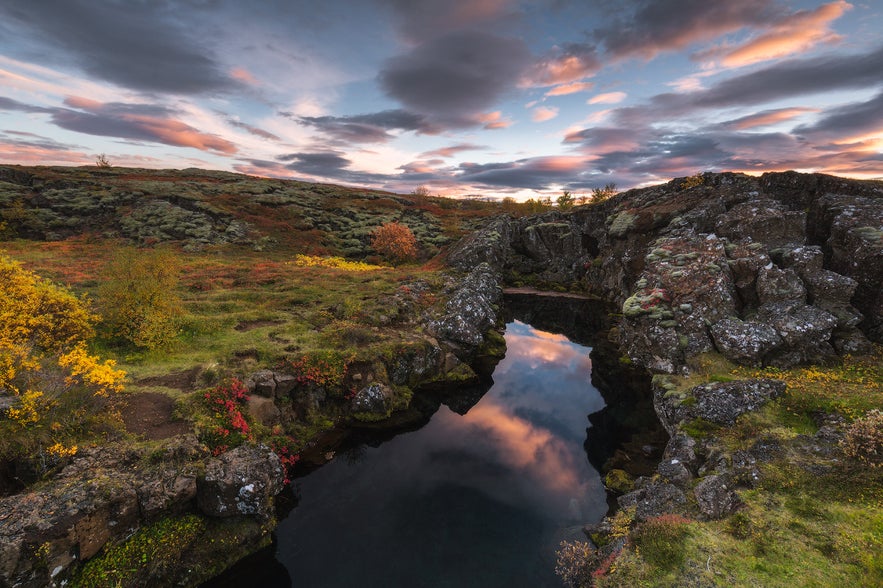 Thingvellir National Park is a remarkable destination where nature and history collide. As the site of Iceland’s first parliament and a geological marvel straddling two tectonic plates, it offers an experience unlike any other.
Thingvellir National Park is a remarkable destination where nature and history collide. As the site of Iceland’s first parliament and a geological marvel straddling two tectonic plates, it offers an experience unlike any other.
Thanks to its location on the Golden Circle, Thingvellir is easy to explore on both self-drive tours and guided tours. Whether you want the freedom to explore at your own pace or prefer a structured itinerary, Thingvellir fits perfectly into any Icelandic adventure.









